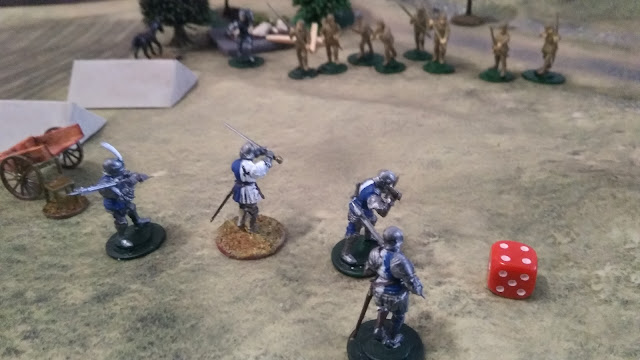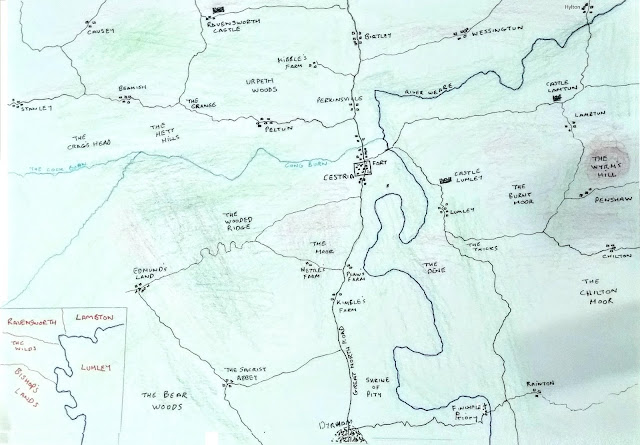Studies into Conflict in Fifteenth Century Cestria, by Professor Augustus P. Farthingdale , Cestria University Press. 1973.
Overview.
Situated on the Great North Road the former Roman Fort and settlement of Cestria was isolated between warring neighbours for much of the later Fifteenth Century. Local families took the opportunity to pursue feuds and raiding across the county in the absence of any central authority. Worse, a local resurgence of the great plague caused uprisings, heresies and roving robber bands among the common folk. All of that before we even mention the Scotchmen reivers from the North.
Legends of the now famous Hooded Robin of the Riverpark stem from this period, as do the tales of Lady Marion of Lumley, the Evil Sheriff of Cestria and Guy of Guis-Birtley. The tale of the Wyrm of the Lambtons, and that of the Hound of the Perkinsvilles are thought to be somewhat earlier.
The Bishop, from his palace, located within the walls of the ancient fort, made efforts to quell the Anarchy that was swirling around the county, sending out his very limited forces in an attempt to regain control. It was an attempt that doomed from the beginning, but gives us an insight into the conflicts that gave rise to colourful local legends.
Foreword
My thanks go to the team from the Whitemore Library, and particularly Head Archivist Miss Lucille Love, for the wide ranging Documents from the period collated for this work. As ever, Miss Lucille affords local scholars great satisfaction.
Using 15mm figures for a warband scale skirmish game has left me unimpressed. The rules for Five Leagues from the Borderlands were really enjoyable and I have a pretty great collection of fourteenth century medieval figures in 15mm, but of late the scale falls to grab me. The problem is almost certainly to do with fielding only a few figures on a tabletop.
To counter this for Five Leagues I'm going to try moving the action into the later Fifteenth Century, using 28mm Wars of the Roses figures, and a mix of scrounged up add ons. I may be a curmudgeon when it comes to elves and goblins, but there are other ways to make this game a fantasy one. This will be Imaginations Fifteenth Century.
The Scots Reivers will be naked Celts fanatics, a nod to the Galwegians at the Standard perhaps. The Peasants and bandits will be similarly scrounged from figures that I have lying around from other periods. I'm curious to see if this will work.
Locations
The Bishop's Lands
The Sacrist Abbey
Finchale Priory
The three farms
The Lambton Lands
Wessingtun
Birtley
Lambtun
The Lumley Lands
Lumley
Penshaw
Chiltun
The Ravensworth Lands
Peltun
Beamish
Causey
Special scenarios (If I were to do "Fantasy!")
The Hound of the Perkinsvilles
The Wyrm of the Lambtun's on the Burnt Moor
The Great Bear of the Woods
The Backstabbing Stanleys
The Shrine of Pity
The Wildmoor at Chilton
The Grey Lady of Beamish
Starting Forces
d6 x Household Men at Arms including the Lord who is one of these and a stand-in for the solo player. M.at.A. are typically a Knight, Squire, or Captain.
d6 x Retinue = Retained soldiery, Typically a Master Archer and Sergeant
of Billmen, or Veteran Soldiers
d6 x Levy = Roll for each 1-2 archers, 3-4 billmen, 5-6 Assorted followers, hired hands, henchmen
and minions. Roll on the table below
d6 x Hangers on = 1-2 idiot yokels, 3-4 nasty gutter rabble, 5-6 wheezy prison in-mates
Followers D100 roll
1-13 Hired Guide
14-24 Stout Yeoman
25-35 Wily Rogue
36-48 Militia Man
49-56 Former Soldier
57-67 Hopeful Youth
68-73 Deranged Wretch
74-81 Angry Villager
82-89 Outcast Drifter
90-100 Roving Wanderer
Five figure groups with the Retinue troops in house colours,
Lambtun Red, Lumley Blue, Ravensworth Green, Finchale Yellow, and the black tabards of the Expelled, renegades and truants.
Establishing threat levels
We need to know what sort of dangers await us and how
serious they are.
There are three types of Threat: Outlaws, Border
Tension and Dark Secrets.
Use the table below to determine the Threat level for each
village in turn.
|
Threat level
|
|
Region
|
Outlaws
|
Border Tension
|
Dark Secrets
|
|
Hinterlands
|
1D3+1
|
1D3+2
|
2D3
|
|
Borderlands
|
2D3
|
1D3+3
|
1D3+1
|
|
Wilderness
|
1D3+3
|
2D3
|
1D3+1
|
|
Campaign goals
The aim of the campaign is to reduce all threats to 0 in
every village.
|
|
Encounters
|
|
To village
|
To region
|
Adventuring
|
Encounter
|
|
1-30
|
1-20
|
0
|
Nobody encountered
|
|
31-60
|
21-40
|
1-15
|
Roadside Encounter
|
|
61-75
|
41-65
|
16-65
|
Combat Encounter
|
|
76-90
|
66-85
|
66-90
|
Roadside AND Combat Encounter
|
|
91-100
|
86-100
|
91-100
|
Monster tracks!
|
|
Roadside Encounters
|
|
1
|
Messenger
|
8
|
Minstrel
|
15
|
Wild Ponies
|
|
2
|
Peasants (2-12}
|
9
|
Lazars
|
16
|
Stray hound
|
|
3
|
Charcoal burners
|
10
|
Miller with cart
|
17
|
Boar
|
|
4
|
Colliers
|
11
|
Outlaws
|
18
|
Shepherd and flock
|
|
5
|
Peddler
|
12
|
Lord/Lady with retinue
|
19
|
Milkmaid and big cow
|
|
6
|
Friar
|
13
|
Merchants
|
20
|
Wolves
|
|
7
|
Monks&/or Pilgrims
|
14
|
Bull or Stag
|
|
|
|
Combat Encounters
|
|
Roll
|
Border
|
Outlaw
|
Dark secret
|
|
1-12
|
Raider
|
Thieves
|
Taken
|
|
13-25
|
Nomad
|
Brigands
|
Corrupt
|
|
26-37
|
Barbarian
|
Deserters
|
Roaming Dead
|
|
38-50
|
Torn Flags
|
Slavers
|
Fanatics
|
|
51-62
|
Military Patrol
|
Desperate Mob
|
The Outcast
|
|
63-74
|
The Untamed
|
Smugglers
|
Cultists
|
|
75-86
|
Skirmishers
|
Renegades
|
Night Folk
|
|
87-94
|
Militia
|
Looters
|
Grave Walkers
|
|
95-100
|
Fang Tribe
|
Rebels
|
Fog Born
|
1D6 to determine the tactical situation.
|
Encounter while Travelling - Roll Encounter type
|
|
1-25
|
Attacked by enemy
|
|
26-70
|
Encounter while travelling
|
|
71-90
|
Located camp *
|
|
91-100
|
Located lair *
|
|
* If
the Threat started the campaign at 3+ and currently has 1 point remaining,
play a Last Stand instead
|
Roll Table theme
1-12 Meadows and fields
13-18 Marshlands
19-28 Near a farm house
29-37 Edge of the woods
38-41 Deep forest
42-46 Foot hills
47-57 Along the road
58-63 Along the river
64-70 Village outskirts
71-74 Old church
75-78 Grave yard
79-88 Overgrown ruins
89-95 Ruined tower
96-100 Cave complex
All a Work in progress
I am still working on converting the rules to Wars of the Roses period and will keep a Campaign rules and background document at:
First Game
Month | Old English | Old High German |
January | Æfterra Gēola "After Yule", or "Second Yule" | Wintar-mánód |
February | Sol-mōnaþ 'mud month,' Bede: "the month of cakes, which they offered in it to their gods." | Hornung |
March | Hrēþ-mōnaþ "Month of the Goddess Hrēþ" or "Month of Wildness"[ | Lenzin-mānod"spring month" |
April | Easter-mōnaþ "Easter Month", "Month of the Goddess Ēostre" | Ōstar-mnod "Easter month" |
May | Þrimilce-mōnaþ "Month of Three Milkings" | Winni-mánód "pasture month" |
June | Ærra Līþa "Before Midsummer", or "First Summer" Þrilīþa "Third (Mid)summer" (leap month) | Brāh-mānod |
July | Æftera Līþa "After Midsummer", "Second Summer" | Hewi-mānod "hay(making) month" |
August | Weod-mōnaþ "Weed month" | Aran-mānod "harvest month" |
September | Hālig-mōnaþ "Holy Month" | Witu-mānod "wood month" |
October | Winterfylleth "Winter full moon", according to Bede "because winter began on the first full moon of that month" | Wīndume-mānod "vintage month" |
November | Blōt-mōnaþ "Blót Month", "Month of Sacrifice" | Herbist-mānod "autumn month" |
December | Ærra Gēola "Before Yule", or "First Yule | Hailag-mānod "holy month" |
The Narrative of Brother Thomas
9th day of Easter Month, Year 1455 of our Lorde.
"This day, Gregory of Finchale, Bishop of Cestria, summoned Sir Hugh of Farthingdale, a Knight from Lancaster, known as "the Hund," a veteran of wars in France and the wilds of Prussia. He commanded him to raise a small retinue and to deal with bandity and heresy among the Bishop's lands to the south of Cestria, sending myself, Father Findlay, His Reverence's Witch-Smeller to join this expedition.
The Knight swiftly gathered his loyal Men at Arms, veterans of the wars he has followed, and raised retinue men and followers.
The Bishop's lands are: The Sacrist Abbey, Finchale Priory and, the three farms.
The first encounter would be on the Great North Road, and an ambush by a "patrol" of the Men of Lord Lambtun who attacked without warning.
 |
| On the Cestria Moor, just north of Plaw's farm, the Lambtun's attempt to ambush the Bishop's men. Perhaps it's because the Bishop seems to have dressed his men in Blue, the Lumley colours rather than the yellow of Finchale. Sir Hugh passes his tactics roll and the encounter be, comes a face off rather than an ambush. |
 |
| Sir Hugh gets stuck in. He wins Initiative and hits, driving back the Lambtun Captain. |
 |
| Clearly I need to paint surcoats. The Bishop's men win. |
 |
| Three of the Lambtun's flee the field. |
 |
| The Lambtun Captain stands rearguard. He is knocked down and captured. The Witch Smeller demands a burning, but the captive is sent back to face the Bishop's justice. Need to sort the painting detail and basing on these figures! |




























